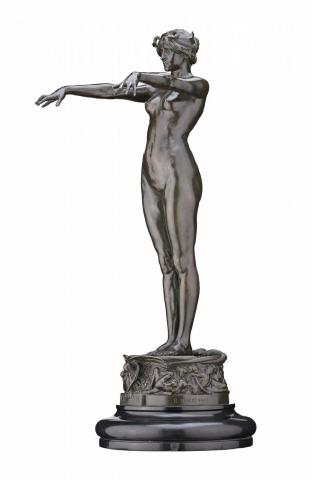CIRCE, 1893 (STATUETTE c.1902-04)
Bertram Mackennal
bronze
57.0 cm height
signed at base: B. MACKENNAL
inscribed at base: KIP KH
Private collection, Cologne, Germany
Deutscher~Menzies, Sydney, 10 December 2008, lot 38
Company collection, Melbourne
Bertram Mackennal: The Fifth Balnaves Sculpture Project, Art Gallery of New South Wales, Sydney, 17 August – 4 November 2007 (another example)
Edwards, D., Bertram Mackennal: The Fifth Balnaves Foundation Sculpture Project, Art Gallery of New South Wales, Sydney, 2007, pp. 31–34, 168–171, front cover and p. 30 (illus., another example), pp. 112 and 211 (illus., details, another example), and catalogue raissoné in accompanying CD-ROM
Circe, 1893, bronze, 240.0 cm height, National Gallery of Victoria, Felton Bequest, 1910
Circe, 1893 (statuette c1902–04), bronze, 57.0 cm height, Art Gallery of New South Wales, Sydney
The femme fatale was greatly in vogue in European art in the latter part of the nineteenth century. She was embraced by such artists as Edvard Munch as in The Vampire, Gustave Moreau in The Apparition, and Franz von Stuck's The Sin of Eve, the serpent wrapped around her naked body. She featured in literature and music - in the plays of Oscar Wilde, Wagner's operas, and Rimsky-Korsakov even devoted the symphonic suite Schéhérazade to her. The leading creative minds of the age drew on a variety of sources, Circe, the pagan counterpart of Salome, attracting the attention of the British painter J. W. Waterhouse to the extent that he painted two major works on Circe in the 1890s. Circe Offering the Cup to Ulysses 1891 is now in the collection of the Gallery Oldham, Greater Manchester, and Circe Invidiosa 1892 in the Art Gallery of South Australia, Adelaide. Bertram Mackennal's fascination with this wily sorceress from ancient Greek mythology led to the creation of a masterpiece; and even his friend Rupert Bunny took up the subject of the bedazzling beauty who turned men, through their lustful appetites, into swine.
Mackennal's Circe brought him fame and unexpected notoriety. The original lifesized plaster was modelled in Paris and exhibited in the Salon of the Socéité des Artistes Français (Old Salon) in 1893. Given a place of prominence, it was awarded an honourable mention and received very good press reviews. The art critic for the Revue des Deux Mondes wrote most favourably - 'The tense, restrained, but triumphant beauty of the sorceress bears itself with a firm and elegant alertness which is free from all trace of vulgarity and all suggestion of the model...'1 R. Jope Slade, writing in the August 1895 issue of the London Magazine of Art, described the work as 'stamped with a remarkable and distinctive individuality.'2 While likewise admired when exhibited at the London Royal Academy of 1894, the activities of the high relief figures around the base caused anxiety 'not being', as Hanging Committee described them 'in accordance with the exigencies of the exhibition'.3 Their actions were those of swine debased through Circe's magic potion. Although the sculpture was given a 'place of honour', the based remained covered from public view by 'a swathing of red baize.'4 The life-sized sculpture was cast in bronze in Paris in 1901, nowadays casting her spell over all who venture near her in Melbourne's National Gallery of Victoria. Her popularity led Mackennal to produce an edition of statuettes in about 1902-04.
1. Quoted in Jope-Slade, J., 'An Australian Quartette', The Magazine of Art, London, [August] 1895, vol. 18, p. 390
2. Jope-Slade, ibid.
3. Ibid., p. 392
4. Ibid.
DAVID THOMAS
